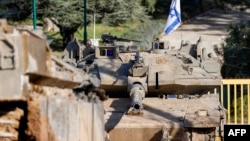Israeli troops remained in some areas of southern Lebanon on Tuesday, despite a deadline for their withdrawal as part of a ceasefire with the militant group Hezbollah.
Israel withdrew from some villages in the region, but said it was leaving forces in place in five positions that it said were necessary to protect parts of northern Israel.
A joint statement from Lebanon’s president, prime minister and parliament speaker Tuesday called on the U.N. Security Council to demand Israel’s immediate withdrawal.
“The continued Israeli presence in any inch of Lebanese territory is an occupation, with all the legal consequences that result from that according to international legitimacy,” the statement said.
The ceasefire agreement called for Israel to withdraw by late January, with Hezbollah also moving away from the border and U.N. peacekeepers deploying in the vacated buffer zone along with the Lebanese troops. An extension pushed the deadline to Tuesday.
The U.N. envoy for Lebanon Jeanine Hennis-Plasschaert and the head of the U.N. peacekeeping mission in Lebanon Force Commander Lt. Gen. Aroldo Lázaro said in a joint statement that another delay in implementing the ceasefire deal “is not what we hoped would happen.”
“We call on both parties to meet their obligations. A sense of safety among communities of southern Lebanon, who are grappling with the wide-scale destruction of their villages and towns, as well as residents of northern Israel who had to leave their homes, will not be built overnight and cannot come from a continuation of military operations,” the statement said.
Israeli Defense Minister Israel Katz said the military “will remain in a buffer zone in Lebanon with five control positions, and will continue to act forcefully and uncompromisingly against any Hezbollah violation.”
The ceasefire reached in late November halted more than a year of fighting in Lebanon, which had intensified in the months ahead of the ceasefire with Israeli troops conducting ground operations inside of Lebanon and repeated airstrikes targeting Hezbollah.
The militants launched a cross-border rocket campaign in October 2023, attacking northern Israel a day after Hamas militants from the Gaza Strip killed about 1,200 people and took 250 hostages in their own attack on southern Israel.
Israel’s counteroffensive against Hamas has killed more than 48,200 Palestinians, according to Gaza’s health ministry, which does not distinguish between combatants and civilians. Israel said it has killed more than 17,000 militants.
The first phase of a Gaza ceasefire is due to end at the beginning of March. So far, the ceasefire has included Hamas releasing 24 hostages and Israel freeing more than 1,000 Palestinian prisoners.
The tentative second phase of the ceasefire plan calls for Hamas to release dozens of remaining hostages in exchange for more Palestinian prisoners, the drafting of a permanent truce and the withdrawal of Israeli forces.
Israeli Foreign Minister Gideon Saar said Tuesday that Israel was ready to open negotiations on the details of the second phase. Those talks were supposed to have started two weeks ago, according to the ceasefire deal.
Hamas and Hezbollah have been designated by the United States and others as terrorist organizations.
Some information for this story was provided by The Associated Press, Agence France-Presse and Reuters.









